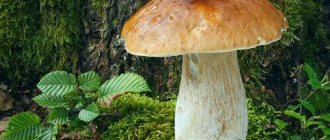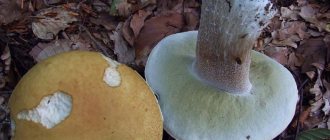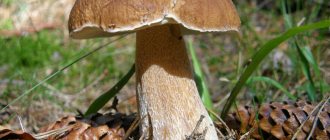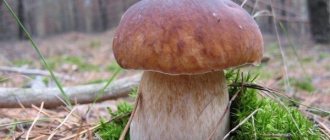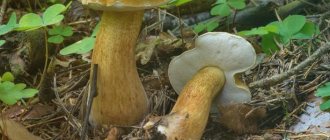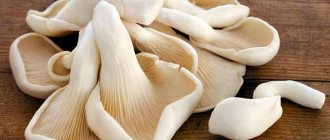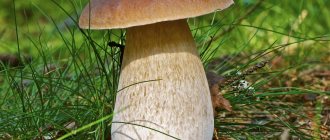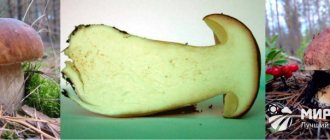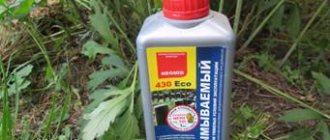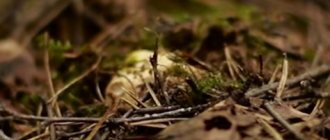Royal oyster mushroom belongs to the class of white steppe mushrooms. In addition, it has the names steppe oyster mushroom, tree boletus and royal trumpeter . It is considered to be one of the most interesting and unpretentious mushrooms, grown both at home and growing in nature.
Widely used in world cooking. The taste is not inferior to the taste of porcini mushroom. It has dietary and medicinal properties. Due to its rapid absorption, it does not cause a feeling of heaviness and overcrowding. In oriental medicine and cosmetology, medicines, tinctures and decoctions are made from it.
What does it look like
The size of the oyster mushroom cap ranges from 2 to 14 cm; it can also grow to about 30 cm in diameter. Young oyster mushroom has a spherical shape, over time it acquires a flat size, perhaps concave or irregular in shape. The structure can be either smooth or scaly. Cracks may appear.
The color ranges from white to yellow, depending on the age of the mushroom. The pulp of oyster mushroom is whitish or pinkish in color, sometimes you can find brown pulp. The smell is non-specific, characteristic mushroom aroma and taste.
The size of the leg varies about 5 cm in height and in width from 1 to 2 cm, and has a denser consistency.
The process of mycelium germination during the incubation period
The most important conditions for mycelium growth are the correct temperature conditions.
After a couple of days, white spots will appear on the substrate. These are mushrooms. This means that the process of growing oyster mushrooms has gone in the right direction. The blocks should be positioned vertically, at a distance from each other. The instructions for germinating mycelium state that if the temperature inside the block is above 26 degrees, then ventilation of the room is necessary. It should be remembered that the room temperature is 4 degrees lower than inside the bag. If the temperature drops, the conditions for mycelium growth will be unsuitable.
After a week, the surface of the substrate takes on a light brown tint, and after two weeks the substrate turns into a dense white block.
Fruiting begins thanks to slits in the bag, where air enters, after about two weeks.
When collected
The fruiting time of the white steppe mushroom, as a rule, occurs in the spring; mushroom pickers collect it from the beginning of spring to the beginning of summer. In a good year, oyster mushrooms can be harvested even in the fall before frost sets in.
Grown at home, it can be harvested throughout the year. It has high yields while providing the appropriate microclimate for growth.
Spread of the fungus
Eringi.
It grows in rather atypical places:
- Pastures.
- Desert areas.
- Other open spaces.
Oyster mushroom bears fruit only in the spring months.
The first fruiting bodies appear already in March (but only in the southern regions). Fruiting ends in mid-May. The distribution area is very large - from the Atlantic coast of Western Europe to the Mediterranean coast and India. In Russia it can only be found in the steppes and deserts of the southern regions.
How is it cultivated?
It can be widely cultivated, so you can not only collect it, but also grow it yourself at home. Provides high productivity due to the rapid development cycle. Oyster mushroom has received widespread use in all corners of the globe. The fungus is resistant to various viruses and bacteria.
The main advantage is excellent tolerance to long-term transportation, when during storage the appearance remains the same and the quality of taste does not change.
The cultivation technique is simple and inexpensive when compared with growing champignons at home. Thanks to the methods of intensive and extensive cultivation of oyster mushrooms, it is possible to easily grow mushrooms in special artificial premises.
Growing Koralevsky oyster mushroom - video
Italian, German and French residents achieve good yields using an extensive method of growing mushrooms. It must be remembered that this method of cultivation requires certain climate and temperature conditions when the crop is harvested strictly in season. The main advantages of this method are low cost, no need to purchase special equipment, and no clear instructions other than seasonality.
With the intensive method of artificial cultivation, a specially equipped room is needed where a certain microclimate will be regulated, which is necessary for the rapid growth of oyster mushrooms. The main advantages of using this method are the ability to grow and harvest crops throughout the year, as well as the ability to automate the entire process.
annotation
Pleurotus eryngii is a popular mushroom due to its excellent cap and stem consistency, culinary qualities and longer shelf life.
In Bangladesh, where Pleurotus mushrooms are very popular, P. eryngii may have a position among consumers, but the mushroom is not currently grown there on a large scale. In this study, 3 strains of P. eryngii such as Pe-1 (native of Bangladesh), Pe-2 (germplasm collected from China) and Pe-3 (germplasm collected from Japan) were cultured on sawdust and rice straw, and were examined parameters of their growth and productivity.
Pe-1 on sawdust showed the highest biological yield and efficiency (73.5%) than other strains.
In addition, the rate of mycelial passage and the number of fruiting bodies of Pe-1 were higher than those of the other two strains. The quality of the mushroom strains was approximately the same. On sawdust, the yield and efficiency were better than when grown on rice straw, but on straw; the fruiting bodies of the mushrooms were larger. This study shows the prospects of P. eryngii cultivation in Bangladesh and suggests further research in a controlled environment to improve yield and productivity.
Preparation of Ering culture
Pure cultures of different strains were prepared on malt extract agar (MEA) medium. The seeded Petri dishes were incubated in a growth chamber at 25 ± 2 °C in the dark for approximately ten days. This culture was used to inoculate the mother culture after completion of the mycelium. Mother culture medium was prepared by mixing sawdust and wheat bran in a 2:1 ratio with 0.2% calcium carbonate. The moisture level of the mixture was maintained at 65%. Polypropylene bags measuring 25 × 17 cm were filled with 250 g of the mixture and packed tightly. The neck was stuffed with cotton wool, covered with brown paper and tied with an elastic band. The bags were sterilized in an autoclave for 1 hour at 121 °C and less than 1 kg/cm2 pressure. The P. eryngii inoculated packets were placed on a rack in the laboratory at 25 ± 2 °C for incubation temperature. The mother culture substrate was colonized by mycelial growth within 15–20 days after inoculation. Fully colonized bags were used for spawning.
Preparing for sowing ering
Two different substrates, namely sawdust (SD) and rice straw (RS), were used as growth media. In the case of SD, sun-dried SD, wheat bran and rice husk were mixed together in the amount of 176 g, 88 g and 11 g, respectively, for each 550 g of substrate. To bring the moisture content to 65%, water was added and CaCO 3 was mixed at the rate of 0.2% of the mixture. The substrate mixture was filled into autoclavable polypropylene plastic bottles (900 ml) and a hole approximately 2/3 deep was made to accommodate the inoculum. The bottles were sterilized at 121 °C for 1 hour at a pressure of 1 kg/cm2 pressure. After cooling to room temperature, sterilized vials were inoculated with a mother culture of selected strains for separate testing. In the case of RS substrate, the dried RS was ground into 2–4 cm and placed in hot water. Half an hour later the burner was turned off and the straw cooled down. After cooling, the straw was spread on a polypropylene sheet to remove excess water. Then polypropylene bags were filled with 500 g of substrate. During packaging, the mother culture of the selected strains for tasting was separately inoculated into the bags. These inoculated vials and bags were incubated in a dark room at 25 ± 2 °C for mycelial growth.
Yering harvest
After the mycelium growth was completed, the bottles with sawdust were opened and soaked in water for 3–5 minutes. But the bags of rice straw were opened with a square cutout (1″×1″) in another area of the culture house. Temperature, relative humidity, and illumination were maintained at 13–22 °C, 70–85%, and about 180–250 lux, respectively. Carbon dioxide concentrations were not monitored or controlled instrumentally. Mushrooms were harvested when the surface of the mushroom cap was flat or slightly curled at the edges of the cap. One stream of mushrooms was collected from each bottle or bag. Mushroom yields and their various quality indicators were regularly recorded.
statistical analysis of erings
The experiment was conducted in a completely randomized design with 10 repetitions ( n = 10). Data were analyzed and graph was generated using statistical software SPSS-12.0 and Microsoft Excel.
Why is it useful?
Oyster mushroom is considered a valuable edible mushroom of high quality; it is rich in protein, containing up to 30% of this important microelement. If we consider the content of useful substances in this mushroom, then it can be compared with meat and dairy products, as well as with vegetables.
Mushroom protein is beneficial for the human body and its heat treatment only increases its usefulness.
The main benefits for humans from consumption:
- Polyunsaturated fatty acids help reduce cholesterol levels and also slow down the processes of atherosclerosis.
- They are extremely rich in polysaccharides, which in turn have a beneficial effect on the human immune system.
- They contain a wide range of B vitamins, ascorbic and folic acids, aimed at improving hematopoietic processes.
- Provides restoration of the body's resources due to the high content of proteins and high-calorie carbohydrates.
- Energy is restored and the central nervous system is strengthened.
- Increases the level of red cells.
- Reduces the risk of formations.
- Normalizes blood pressure, improves the functioning of the heart muscle and blood vessels.
- Protects against disorders such as arrhythmia, tachycardia, ischemia.
- It has a beneficial effect on restoring tooth enamel due to its phosphorus and calcium content.
- Helps in the process of reducing cholesterol and radionuclides.
- Due to the absorbent action, toxins and waste are neutralized.
Harm and contraindications
The pulp of these mushrooms contains chitin, which is practically not absorbed by the human body. And this substance is destroyed only under the influence of high temperatures. Therefore, oyster mushrooms must be cooked. In order for them to be beneficial, it is recommended to use them in food no more than 2 times a week.
- Experts do not recommend giving mushrooms to children under five years of age.
- Teenagers should eat them with great caution and in small quantities. This also applies to older people.
- If you have problems with the liver, gastrointestinal tract, kidneys and pancreas, you should limit the amount of product consumed.
- People susceptible to allergic reactions should be careful when collecting and preparing. Since erynghi seed can cause allergies when inhaled.
How to prepare
In terms of taste and smell, oyster mushroom is considered an original and unusual product. The most common cooking method is frying in various oils. It is pre-washed in running water and cut into slices, strips or cubes. Fried mushroom can be eaten as an independent dish or used to add to salads, purees, soups, and borscht.
In cooking, oyster mushrooms are often used to prepare broths; later, aromatic soup or pickle is made from it. It is ideal for dishes with pasta, meat sauces, and all vegetables. In various recipes, it easily replaces the taste of champignons, porcini and other varieties of mushrooms. Oyster mushrooms are also successfully canned and used for long-term storage in closed jars.
Taste qualities
Yeringi taste great. They are revered in the kitchens of all countries of the world. People of China and European countries especially adore them.
Oyster mushrooms are tender and have a faint “mushroom” flavor. They have virtually no odor. When chewing, you may feel some fibrousness and a slight harshness. To preserve these qualities, moderate food processing is required. The structure of the cap differs from the stem. It is more porous and soft, and the leg is fibrous.
The shelf life in raw form is quite long - they remain fresh for up to three weeks in the refrigerator. For storage, you can use either an open food container or a paper bag.
We talked in more detail about storing oyster mushrooms in this article.
Description, habitat, reproduction
The culture we are considering has several names - steppe oyster mushroom, royal oyster mushroom, steppe white mushroom, Eringi. It prefers a warm climate and, as the name suggests, develops in the steppes and pasture meadows. The richest harvest of Yeringa is collected by mushroom pickers in Asia and North America, however, the mushroom is also found quite often on the European territory of our country.
It bears fruit in the off-season, since the most favorable temperature for fruit ripening is 17 – 23 degrees. Outwardly it resembles a chanterelle, the cap is dense, fleshy, from 5 to 20 centimeters in diameter, located on a massive, cylindrical stalk up to 3 centimeters wide. The reverse side of the “head” is lamellar, the outer side resembles a funnel with asymmetrical edges. The surface of the skin is covered with tiny scales in the center and is smooth to the touch.
The smaller the mushroom, the richer and darker its color - from light cream to red-brown. Popular in Chinese and European cuisine, it can be either an ingredient for dishes or an independent delicacy. Millions of housewives around the world prepare soups, salads, sauces, delicious pastries from fruiting bodies, and also stock up on mushrooms, twisting them with spices in a marinade.
It is worth noting that the steppe oyster mushroom is in great demand as a healthy, tasty product, which is why the mushroom began to be cultivated on a commercial basis. This allows mushroom lovers to enjoy the product almost all year round.
Notes
- ↑ Georgios I. Zervakis1, Giuseppe Venturella and Kalliopi Papadopoulou.
Genetic polymorphism and taxonomic infrastructure of the
Pleurotus eryngii
species-complex as determined by RAPD analysis, isozyme profiles and ecomorphological characters // Microbiology. - 2001. - T. 147, issue. 11. - pp. 3183–3194. - ↑ 1 2 Urbanelli S., Della Rosa V., Fanelli C., Fabbri A.A. and Reverberi M.
Genetic diversity and population structure of the Italian fungi belonging to the taxa Pleurotus eryngii (DC.:Fr.) Quèl and P. ferulae ( DC.:Fr.) Quèl (English) // Heredity. - 2003. - No. 90. - P. 253-259. - ISSN0018-067X.

